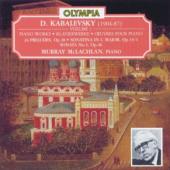Kabalevsky: Piano Music / Mclachlan
 | Label: OLYMPIA Catalog: OCD266 Format: CD Murray McLachlan: pianoKabalevsky: Piano Sonata No. 3 in F major opus 46 / Piano Sonatina No. 1 in C major opus 13 No. 1 / Twenty-Four Preludes for piano opus 38 In his enthusiastic accompanying notes Murray McLachlan refers to Kabalevsky's "direct yet memorable" qualities and, more specifically, to the "terrifying" development section of the Third Sonata's first movement. He also quotes a passing reference to the composer's "profound psychological content". But this is surely overstating the case (the latter comment reads suspiciously like communist propaganda) because for all its fluency, its passing fancies and attractions, Kabalevsky's style is facile and derivative. True, the 24 Preludes flash with intermittent brilliance but so far from being deeply rooted in Russian folk melody they suggest several ill-digested influences; those of Tchaikovsky, Mussorgsky, Stravinsky and most of all, Prokofiev. The true source of so much self-conscious whimsy and iconoclasm is not hard to fathom. The First Sonatina, too, while useful teaching fodder, is oddly without quality (the central Andantino is notably arid) and only the Third Sonata shows Kabalevsky at his consistent best. While hardly part of the standard repertoire (McLachlan's claim) the occasional performance and recording bear witness to its piquancy, its propulsive energy and character.
|











